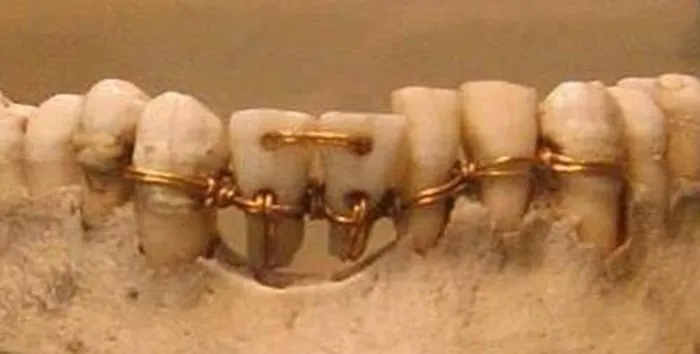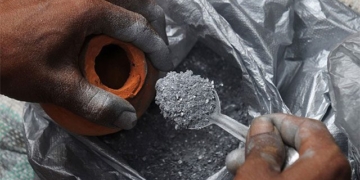In ancient times, humans began to study and seek materials to replace lost teeth, improving their ability to chew and eat. By the early 19th century, techniques for permanent dental implants were researched, developed, and the materials used started to be identified.
Dental Prosthetics Made from Various Materials
There have been many different traces of dental grafting; people used materials and tools from everyday life, such as bamboo, metal pins, animal bones, shells, and ivory to replace lost teeth.
The first recorded case of a metal dental prosthetic was found in the remains of an Egyptian king. Around 1000 BC, a bronze peg was inserted into the upper jawbone, though it is uncertain whether it was placed while the king was alive or posthumously.
By 300 AD, the Phoenicians used carved ivory shaped like teeth, securing them with gold wire. Around 600 AD, the Maya began researching and experimenting with materials to replace lost teeth to enhance chewing. They used large shells, grinding them into shapes resembling teeth for grafting. Later, in the 1970s, X-rays revealed bone formation around the grafts.
From 1500 to the early 1800s, dental grafting became heavily associated with class discrimination in society. Teeth were collected and purchased from the poor or corpses for grafting purposes. However, this practice gradually faded away for various reasons, particularly due to secondary infections from diseases.
A famous historical figure known for wearing dentures is George Washington (an American military leader, statesman, one of the founding fathers, and the first President of the United States from 1789 to 1797). He had a complete set of dentures made from ivory (sourced from the tusks of hippos or walruses) and a set carved from a piece of ivory. However, these dentures not only caused him pain while eating but also made him slur his words during speeches, and they gradually deteriorated.

Dental techniques on a 4,000-year-old mummy. The two in the middle are teeth from another person. (Image: Ancient Origins).
Improvements in Dental Implantation
By the early 19th century, doctors experimented with platinum, gold, and other materials for implants, but the results were not promising, with a high rejection rate. In 1937, the Stroke brothers observed doctors successfully placing orthopedic screws made from Vitallium (a chromium-cobalt alloy) into hip bones. They conducted experiments grafting these into humans and dogs to restore lost teeth. They are considered the first to achieve successful grafting within bones. However, grafting faced the disadvantage of rejection, where the body would reject the materials implanted into the bones. For a successful graft, the replacement tooth and bone needed to bond securely.
Dental Implants
In the 1937s, many new advancements emerged, but the most significant breakthrough came when Professor Per Ingvar Branemark (1929-2014), a Swedish orthopedic research professor, discovered the implant dental grafting method.
In 1952, while leading a research team at Lund University, Professor Branemark accidentally discovered titanium by placing it into the femur of a rabbit to temporarily stabilize a fracture. After a few months of observation, when he intended to remove the titanium peg, he found it impossible to do so and left it in the rabbit’s body. Through continued observation, Professor Branemark noted that there were no adverse reactions between the rabbit’s body and the titanium peg.
Continuing his research, he documented that there were no negative biochemical reactions affecting the living body, coining the term “osseointegration.” From this, he confirmed that using titanium for dental implants in the jaw would likely be successful.

Professor Per Ingvar Branemark discovered the implant grafting material made of Titanium in 1952.
In 1965, Professor Branemark performed the first successful dental implant using a titanium fixture. Forty years later, this implant still existed and functioned very well for chewing, even as many natural teeth fell out due to age, and it lasted for the patient’s lifetime until their passing.
The implant fixture is made of titanium and is placed directly into the jawbone to replace the lost tooth root. After a healing period and successful osseointegration, the dentist will create a porcelain crown on the implant. This crown functions like a natural tooth because it has both a root supporting it below and a crown above.
Since then, titanium has paved the way for the success of dental implants. After identifying suitable materials, scientists continuously improved the shape, structure, and surface to increase the success rate while ensuring durability for future chewing.
Due to various factors such as age, accidents, or congenital issues, many people experience permanent tooth loss. In such cases, there are three forms of dental restoration to choose from: removable dentures, fixed bridges, or dental implants.
However, only dental implants can be considered a permanent solution. Removable dentures typically last about 3 to 5 years, while fixed bridges last only 7 to 10 years. In contrast, dental implants usually feature both a tooth root and crown replacement, making them significantly more effective than the other two methods.


















































